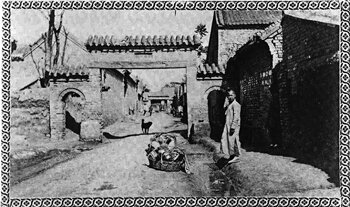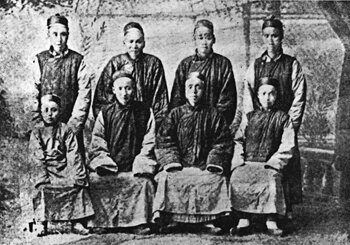Warning: Parameter 1 to plgContentLoginToRead::onAfterDisplayTitle() expected to be a reference, value given in /home/joomla789/domains/jewishtimesasia.org/public_html/libraries/joomla/event/event.php on line 67
| The Great Wail of Kaifeng |

|

|
|
Each year, many Jewish families sit at the seder table, partake in of the nostalgic, symbolic foods, enjoy the cups of sweet wine, recite the historic words of the Haggadah, listen to the familiar sound and rhythm of the youngest child reciting Mah Nishtanah (Four Questions), and relish the delicious meal.
Passover is indeed a family celebration, and no one should celebrate the holiday alone. The experience of Pesach is essentially family oriented. During Pesach, there is no individual “Iâ€, but rather the plural, “We.†Together, we experienced the bitterness of slavery in Egypt, we witnessed the miraculous deliverance from slavery, and we tasted the fruits of freedom. However, one of the hidden and ignored messages of Pesach is the importance of remembering that we are one family and one people. As we suffered and experienced both the bitterness and sweetness, we should always care for each other, help each other, and certainly hear the cry of a fellow Jew in need. After all, we are family and all Jews are in e family! My family lived in Japan for many years, where I was asked by the Lubavitcher Rebbe to serve as the rabbi of the Jewish Community of Japan. When living in Tokyo, I researched the history of the Jewish experience from Asia to India to Japan and was enthralled by the fascination but little –known exotic experience of the Chinese Jews.
Jews came to China from Persia on the Silk Road about 1000 years ago. They were very warmly received by the Emperor and were invited to live near the imperial palace, in the capital city of Kaifeng. The Emperor requested that the Jews keep their ancestral traditions and be an asset to China. They lived as faithful Jews and observed a Jewish way of life. They built a magnificent synagogue, the Temple of Purity and Truth, which was Chinese in style and Jewish in content. It had a prayer hall, a mikveh, yahrzeit chapel, and many Torah scrolls. The street of the synagogue, to this very day, is still called Teaching Torah Lane South, and as a courtesy and gesture of respect, the Chinese did not carry pork on the street of the synagogue. Rabbis trained their sons to be rabbis, and they kept community records and produced prayer books and Hebrew school textbooks. With the passing of time, the open and flourishing China closed its borders, and the local Jews lost all contact with the outside world. The synagogue was destroyed by floods and local wars, and had to be rebuilt several times. Sons of rabbis frequently tool more lucrative and prestigious positions, and the Jewish community declined, intermarried, and assimilated. Over time, the Chinese Jews became very poor. They lost all knowledge of Hebrew; rituals and worship were no longer observed; the traditions of their ancestors were neglected; and some did not even know which day of the week was the Sabbath. The Jewish community was now in crisis. Loyalty to ancestors is important in China, and Jews bore great guilt for not being loyal to their ancestral traditions.       What should they do, and what could they do? They debated among themselves for decades until they decided to swallow their pride and make a bold decision. They agreed to humiliate and embarrass themselves and write a letter to the outside world, asking for help to save their community. On August 23, 1850, the Chinese Jews of Kaifeng sent a desperate cry for assistance. “Morning and night, with tears in our eyes and with offerings of incense, do we implore that our religion may again flourish…If we can rebuild our synagogue, it will give great joy to the community…Our synagogue has no rabbi, our mikveh and ark are in ruins…The sight of our synagogue brings grief to our hearts and tears to our eyes…If we again have a rabbi and teacher, and rebuild our synagogue, our future as Jews will be secure.†This letter was endorsed by the chief rabbi of the British Empire, as well as Rabbi Isaac Lesser in America. Both spoke of the mitzvah of saving this Jewish community. Judah Touro of New Orleans offered to help and left a fortune in his estate for any rabbi or teacher to travel to China to teach a desperate community. Rabbi Lesser wrote that it would be a disgrace if we abandoned this isolated Jewish community and if their plea would fall on deaf ears. What happened? Sadly and tragically, no one went to help them. We abandoned them and did not hear their cry and plea for help. Visitors came and took a photo. National Geographic wrote a famous article in 1907. Pearl Buck wrote a novel, Peony, about the Chinese Jews. The Torah scrolls of Kaifeng are now in various libraries or lost. The Haggadah and Megillah are collector’s items.
The Royal Ontario Museum in Toronto has many synagogue artifacts and, surprisingly, the Washington Cathedral has the stone lotus bowl that was used for washing hands before eating bread. Hebrew Union College has the community’s siddurim, chumashim, community documents, and records. The synagogue no longer stands, but the street of the synagogue, with its historic name, still remains. One Chinese Jewish family still lives on this street, as they have for many centuries. Each year, I visit Kaifeng. The remaining Jewish descendants are very poor. I shiver when I meet descendents of the Ai family, for that name still rings in my ear. There is a model of the Chinese synagogue at the Diaspora Museum in Tel Aviv, and this synagogue appeared on an Israeli Rosh Hashanah stamp. One young Chinese Jew recently studied at Bar Ilan University in Israel for one year and at a yeshiva in Jerusalem for two years. Some Jews in Kaifeng now meet on Friday nights to recreate a Shabbat experience and learn to read Hebrew. One family from Kaifeng even settled in Israel. Recently in Kaifeng, on the very first day of school, the teacher asked all the first graders where they were from…one little boy responded Israel and the teacher and the entire class started to laugh, as they never heard of this city or street in China. His mother told him that they were indeed from Israel, and she herself did not know exactly where is was, but this was their family tradition and “Jewish†is written on their ID cards. It is now Pesach time. From China, we can learn the results of not responding to a Jew in need. When a Jew cries out, it is our responsibility as Jews to answer, to respond, and to help. I am haunted by the Chinese Jews and our response of indifference. Pesach is a festival of history, and this year, may we all learn from this vital lesson from the history of the Jews of China. Reprinted with the permission of the author, Rabbi Marvin Tokayer, now located in New York, is the lifetime honorary rabbi of the Jewish Community of Japan  Photographs reprinted with permission from The Jewish Historical Society, Hong Kong (Issue April 2007)Â
|

















 Â
 